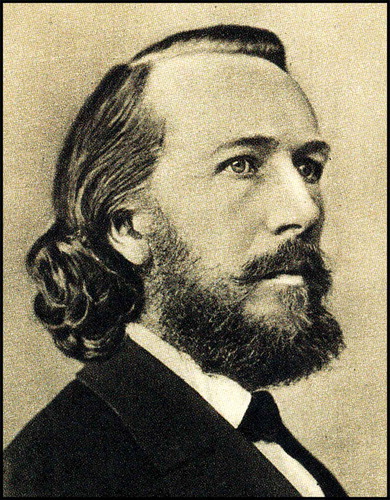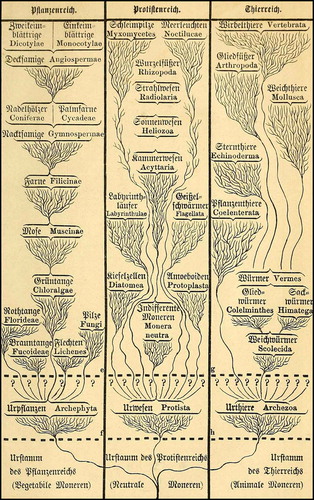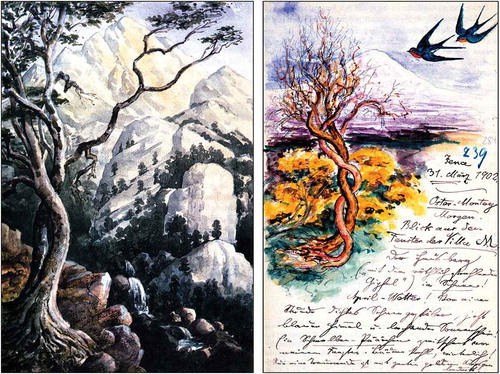ABSTRACT
In this Addendum to an article in Nature commemorating the 100th anniversary of Ernst Haeckel’s death (9 August 1919), we recall the largely forgotten fact that Haeckel (1868) was an early proponent of the concept of an “Anthropozoic Age”, a 19th-century anticipation of the “Anthropocene”. Haeckel in particular highlighted man’s extensive remodeling of the planet in ancient forests. Earlier influences on Haeckel included Alexander von Humboldt (1769–1859) and dozens of similar writers in the 19th century Romantic era, including the Italian geologist and priest Antonio Stoppani (1824–1891), and the American diplomat and environmentalist George P. Marsh (1801–1882). Starting in the 1840s, Marsh described in extraordinary detail the destructive influence of mankind on natural ecosystems, again with particular emphasis on the destruction of forests. Marsh, like Haeckel after him, was a pioneer in describing the far-reaching human re-modeling of the planet that they and their colleagues presciently labeled the “Anthropozoic Age”.
Introduction
The zoologist, artist and philosopher of science Ernst Haeckel (1834–1919) () helped popularize, or in some cases coined, a number of key biological terms still with us, including ‘ecology’, ‘ontogeny’ and ‘phylogeny’. Via public lectures and his lavishly illustrated books he also popularized and adapted Charles Darwin’s (1809–1882) theory of biological evolution through variation and natural selection.Citation1,Citation2 Less well-known, but equally important, is the fact that Haeckel was one of the first to use the phrase “Anthropozoic Age”, with the specific goal of highlighting man’s destructive impact on the planet.Citation3
Figure 1. The German evolutionary biologist, artist and philosopher of science Ernst Haeckel (1834–1919). The image was taken in 1872. The then 38-year-old Professor was already famous for his books and lectures on Darwinian evolution and related topics (U. Kutschera, private collection)

In this article, we describe Haeckel’s anticipation of the modern concept of the Anthropocene, with particular stress on man’s relationship to forests. We also discuss earlier 19th century figures who, at times, went even further than Haeckel in lamenting man’s destructive influence on the planet, including human impacts on climate change. One especially strong influence on Haeckel’s work was that of Alexander von Humboldt (1769–1859), whose writings had an enormous impact on naturalists and other environmentally minded writers throughout the 19th century. How much in Haeckel’s work on “ecology” derived from the holistic themes found in the works Humboldt and his Romantic contemporaries cannot be answered in a brief article. Clues concerning the depth of that influence are discussed below.
‘The age of man’: Haeckel and Wallace
In his first book dealing with evolution, Generelle Morphologie (1866),Citation4 Haeckel depicted one of his most famous “trees of life”, restricted in this case to animals, with mankind placed prominently at the top of the growing system. He also published the first “tree of plants” known in the history of biology.Citation5 shows one of Haeckel’s lesser-known phylogenetic schemes of life, reproduced from his Natürliche Schöpfungsgeschichte (Natural History of Creation).Citation6 His message is obvious: all organisms descended from “neutrale Moneren” (neutral bacteria), with the “Pflanzenreich” (Kingdom Plantae), the “Protistenreich” (Kingdom Protoctista), and the “Thierreich” (Kingdom Animalia)Citation7 as the three major “branches of life”.
Figure 2. Monophyletic tree of life published by Haeckel 1868 in his Natural History of Creation. The drawing indicates that all organisms on Earth descended from “neutral monera” (i.e., bacteria), and then split into separate lineages of plants (Pflanzenreich), protists (Protistenreich) and animals (Thierreich).Citation6

Figure 3. Two watercolors by Ernst Haeckel in which trees and other plants are depicted in their natural environment. The landscape shown on the left (drawn 1896), as well as the letter of Haeckel, dated 31.03.1902 (right image), were created for Mrs. Frida von Uslar-Gleichen (1864–1903) (U. Kutschera, private collection)

In his Generelle Morphologie, Haeckel discussed what he referred to as “five ages of geologic time”, modifying similar schemas found in earlier 19th century geologists, which he designated as the Primordial-Zeit, Primär-Zeit, Secundär-Zeit, Tertiär-Zeit, and Quartär-Zeit.Citation4 Two years later (1868), he explained in depth the meaning of the fifth “Quartärzeit” (or “Culturzeit”, Cultural Era) in his Natürliche Schöpfungsgeschichte. In the following striking passage, which we give first in his German version, and then in English translation, he summarized his views as follows: “Den fünften und letzten Hauptabschnitt der organischen Erdgeschichte bildet die Quartärzeit oder die Culturzeit, derjenige, gegen die Länge der vier übrigen Zeitalter verschwindend kurze Zeitraum, den wir gewöhnlich in komischer Selbstüberschätzung die ‘Weltgeschichte‘ zu nennen pflegen. Da die Ausbildung des Menschen und seiner Cultur, welche mächtiger als alle früheren Vorgänge auf die organische Welt umgestaltend einwirkte, dieses Zeitalter charakterisiert, so könnte man dasselbe auch die Menschenzeit, das anthropolithische oder anthropozoische Zeitalter nennen. Es könnte auch das Zeitalter der Culturwälder heißen, weil selbst auf den niedrigeren Stufen der menschlichen Cultur ihr umgestaltender Einfluß sich bereits in der Benutzung der Wälder und ihrer Erzeugnisse, und somit auch in der Physiognomie der Landschaft bemerkbar macht. … Der biologische Charakter der Quartärzeit liegt wesentlich in der Entwicklung und Ausbreitung des menschlichen Organismus und seiner Cultur. Weit mehr als jeder andere Organismus hat der Mensch umgestaltend, zerstörend und neubildend auf die Thier- und Pflanzenbevölkerung der Erde eingewirkt. Aus diesem Grunde, – nicht weil wir dem Menschen im Uebrigen eine privilegierte Ausnahmestellung in der Natur einräumen – können wir mit vollem Rechte die Ausbreitung des Menschen mit seiner Cultur als Beginn eines besonderen letzten Hauptabschnitts der organischen Erdgeschichte bezeichnen“ (Haeckel 1868, 300–301)“.Citation6
In English, Haeckel’s passage reads as follows: “The fifth and last main division of the organic history of the earth is the quaternary epoch, or era of civilization, which in comparison to the length of the four other epochs almost vanishes into nothing, though with a comical conceit we usually call its record the ‘history of the world’. As the period is characterized by the development of man and his culture, which has influenced the organic world more powerfully and with greater transforming effect than have all previous conditions, it may also be called the era of man, the anthropolithic or anthropozoic period. It might also be called the era of cultivated forests (Culturwälder), because even at the lowest stage of human civilization man’s influence is already perceptible in the utilization of forests and their products, and therefore also in the physiognomy of the landscape … The biological characteristic of the quaternary epoch lies essentially in the development and dispersion of the human organism and his culture. Man has acted with a greater transforming, destructive, and modifying influence upon the animal and vegetable population of the earth than any other organism. For this reason, and not because we assign to man a privileged exceptional position in nature in other matters, we may with full justice designate the development of man and his civilization as the beginning of a special and last main division of the organic history of the earth.” .
This characterization of the “Anthropozoic” era is one of the first extended descriptions of the “Age of Man” in the history of biology. Three decades later, Haeckel’s contemporary, Alfred Russel Wallace (1823–1913), likewise referred to the “Anthropozoic” era,Citation8 without mentioning the earlier descriptions published by Haeckel or other early figures who used the term, whom we note later. Both Haeckel’s and Wallace’s definitions have largely been ignored by later scientists, who in our own era, re-invented the idea of a geologic “Age of Man”.
Alexander von Humboldt and George P. Marsh
The great German naturalist and philosopher Alexander von Humboldt, whose influence was felt throughout the 19th century by writers like Haeckel, also took up these issues, and was one of the first to define the term ‘climate’ in its modern sense. In the first book of his encyclopedic five-volume Kosmos: Entwurf einer physischen Weltbeschreibung (1845–1862), he argued that the term ‘climate’ should be applied to all changes in the atmosphere (temperature, humidity, barometric pressure, wind speed, etc.).Citation9 Humboldt also discussed at length the negative impact that humans were having on climate and the environment in general.
Not long afterward, the American diplomat and environmentalist George P. Marsh (1801–1882) vastly amplified on these topics. In 1847, only two years after the first volume of Kosmos was published, Marsh gave a remarkable speech at the Agricultural Society of Rutland County (Vermont, USA), whose insights remain profound even by modern standards – and which were considerably more sophisticated than anything Haeckel later wrote on the topic.Citation10 Marsh’s speech included comments on systems-level complexities in anthropogenic climate change that remain pertinent 170 years later: “Man cannot at his pleasure command the rain and the sunshine, the wind and frost and snow, yet it is certain that climate itself has in many instances been gradually changed and ameliorated or deteriorated by human action. The draining of swamps and the clearing of forests perceptibly effect the evaporation from the earth, and of course the mean quantity of moisture suspended in the air. The same causes modify the electrical condition of the atmosphere and the power of the surface to reflect, absorb and radiate the rays of the sun, and consequently influence the distribution of light and heat, and the force and direction of the winds. Within narrow limits too, domestic fires and artificial structures create and diffuse increased warmth, to an extent that may effect vegetation. The mean temperature of London is a degree or two higher than that of the surrounding country, and Pallas [Peter Simon Pallas, 1741–1811] believed that the climate of even so thinly a peopled country as Russia was sensibly modified by similar causes.” (Marsh 1847).”Citation10
In 1864, four years before Haeckel’s work, Marsh wrote his masterpiece on mankind’s remodeling of the planet, again anticipating views that only became common in the late 20th and early 21st century. The depth of his vision is suggested by the title of his work alone: Man and Nature: Or, Physical Geography as Modified by Human Action.Citation11
In a final edition of Man and Nature, published in 1874 under the title The Earth as Modified by Human Action: A New Edition of ‘Man and Nature’, Marsh praised the use by the Italian priest-geologist Antonio Stoppani (1824–1891) of the phrase “Anthropozoic era,” misleading Paul Crutzen and other modern adherents of the Anthropocene into believing that Sapponi coined the term, which was in fact current in popular writings at least two decades earlier.Citation12 One year after Stoppani adopted the phrase, Marsh wrote: “In a former chapter I spoke of the influence of human action on the surface of the globe as immensely superior in degree to that exerted by brute animals, if not essentially different from it in kind. The eminent Italian geologist, Stoppani, goes further than I had ventured to do, and treats the action of man as a new physical element altogether sui generis. According to him, the existence of man constitutes a geological period which he designates as the Anthropozoic era. ‘The creation of man’, says he, ‘was the introduction of a new element into nature, of a force wholly unknown to earlier periods’.” (Marsh 1874).Citation12
Marsh’s ideas on deforestation go far beyond those of Haeckel after him, though not necessarily beyond those of Humboldt, who, like Marsh, was also a global champion of reforestation. In one of his “Conservation Writings” he argued that: “We have now felled forest enough everywhere, in many districts far too much. Let us restore this one element of material life to its normal proportions, and devise means for maintaining the permanence of its relations to the fields, the meadows and the pastures, to the rain and the dews of heaven, to the springs and rivulets with which it waters down the earth”.Citation13
Marsh’s views of mankind’s massive remodeling of the planet were summed up by him in a letter in a striking phrase that could in many ways be taken as the motto of modern views of the Anthropocene: “ … whereas [others] think the earth made man, man in fact made the earth” (Marsh 1874).Citation12
Thomas W. Jenkyn and Samuel Houghton
Historians of science have long recognized that revolutionary ideas in a deep sense are collective achievements and not the creations of lone geniuses. The holistic views of nature expressed in the works of Marsh or Haeckel or their colleagues were common in the Romantic movement throughout the late 18th to mid-to-late 19th centuries. Due to the work of Rousseau, Goethe, Humboldt, Emerson, Thoreau, and hundreds of others, the idea of something resembling the Anthropocene was “in the air” throughout that period. Nearly every side of Haeckel’s views of reality, like those of Humboldt and Marsh before him, reflect the holistic views of nature expressed in that movement.
Hence, the word ‘Anthropozoic’ was current much earlier, e.g. in the geological writings of an influential English Congregational minister, Thomas W. Jenkyn (1794–1858), that appeared in 1854 in the journal The Popular Educator.Citation14 Marsh’s misattribution of its coinage to Stoppani has led to much later historical confusion. E.g., Marsh is followed on this point by P. J. Crutzen, the researcher most often credited with popularizing the modern concept of the Anthropocene (see below), and his colleagues in their influential review of its 19th century antecedents. After Jenkyn, but long before Stoppani, Marsh, and Haeckel adopted it, the word ‘Anthropozoic’ also appeared in the Manual of Geology published in 1865 by a well-known anti-Darwinian geology professor in Dublin, Reverend Samuel Houghton (1821–1897). For further discussion of this topic, see Hansen (2013).Citation14
The Anthropocene in the 21st century
During the 1980s, the biologist Eugene F. Stoermer (1934–2012), a specialist in microalgae, first used the term ‘Anthropocene’,Citation15 but it was only after the publication of an article coauthored with the atmospheric chemist Paul J. Crutzen (born 1933), entitled “The Anthropocene”, that this neologism gained popular currency.Citation16 Crutzen, who won a Nobel Prize for his studies of atmospheric ozone depletion, subsequently argued that the influence of human behavior has such a profound effect on Earth’s atmosphere that it should be viewed as the mark of a new geological epoch. According to Crutzen, at least as he originally conceived it, the Anthropocene started, or vastly accelerated, in the later Industrial Revolution, which he tentatively dated to the late 1700s, coinciding with Watt’s invention of the steam engine. Others, as Crutzen acknowledged, preferred to date the Anthropocene much earlier. Thus, many paleontologists and archeologists today argue that massive re-modeling of animal and plant life (e.g. involving the prehistoric destruction of megafauna), or geological and climate modification (sequelae of ancient deforestation and desertification) justify dating the epoch to the early Holocene or even earlier.
In many ways, the latter views coincide more closely with those of 19th-century figures, like Haeckel or Marsh, than with Crutzen and his modern colleagues. But the dating dispute is largely a question of detail, and does not reflect any deep disagreement about the severity of human impacts on the planet – which can be traced back not just a few centuries in human history, but many millennia.
Acknowledgments
This brief biohistorical account is dedicated to the memory of Stanford-Professor Winslow R. Briggs (1928–2019), who was not only a world-class molecular biologist, but also a naturalist, who protected the Henry W. Coe State Park (San José, California). The cooperation of the authors was supported by the Alexander von Humboldt-Foundation, Bonn, Germany (Stanford Fellowship to U. K., Institute of Biology, University of Kassel, Germany).
References
- Kutschera U. Ernst Haeckel’s biodynamics 1866 and the occult basis of organic farming. Plant Signal Behav. 2016;11(7):1–5. doi:10.1080/15592324.2016.1199315.
- Kutschera U, Levit GS, Hossfeld U. Ernst Haeckel (1834–1919): the German Darwin and his impact on modern biology. Theory Biosci. 2019;138:1–7. doi:10.1007/s12064-019-00276-4.
- Watts E, Kutschera U, Levit GS, Hossfeld U. Haeckel’s prescient view. Nature. 2019;570:164. doi:10.1038/d41586-019-01822-2.
- Haeckel E. Generelle Morphologie der Organismen. Vols 1 and 2. Berlin, Germany: Verlag Georg Reimer; 1866.
- Hossfeld U, Watts E, Levit GS. The first Darwinian phylogenetic tree of plants. Trends Plant Sci. 2017;22:99–102. doi:10.1016/j.tplants.2016.12.002.
- Haeckel E. Natürliche Schöpfungsgeschichte. Berlin, Germany: Verlag Georg Reimer; 1868.
- Kutschera U. Haeckel’s 1866 tree of life and the origin of eukaryotes. Nat Microbiol. 2016;1(8):16114. doi:10.1038/nmicrobiol.2016.114.
- Kutschera U. The age of man. A father figure. Science. 2013;340:1287. doi:10.1126/science.340.6138.1287-a.
- Humboldt VA. Kosmos. Entwurf einer physischen Weltbeschreibung. Stuttgart und Tübingen: J. G. Germany: Cotta’scher Verlag; 1845.
- Marsh GP. Address delivered before the Agricultural Society of Rutland County, Sept. 30, 1847. Rutland, US: Vermont, Printed at the Herald Office; 1848. p. 1–24.
- Marsh GP. Man and nature. Or, physical geography as modified by human action. New York, US: Charles Scribner & Co.; 1864.
- Marsh GP. The earth as modified by human action: a new edition of man and nature. New York,US: Charles Scribner & Co.; 1874.
- Marsh GP. So great a vision: the conservation writings of George Perkins Marsh. In: Trombulak SB, editor. Life and Letters of George Perkins Marsh. Hanover (New Hampshire): University Press of New England; 2001. p. 186.
- Hansen PH. The summits of modern man: mountaineering after the enlightenment. Cambridge (Massachusetts): Harvard University Press; 2013. p. 291.
- Steffen W, Grinevald J, Crutzen P, McNeill J. The Anthropocene: conceptual and historical perspectives. Phil Trans R Soc A. 2011;369:842–867. doi:10.1098/rsta.2010.0327.
- Crutzen PJ, Stoermer EF. The “Anthropocene”. IGBP Global Change Newsl. 2000;41:17–18.
